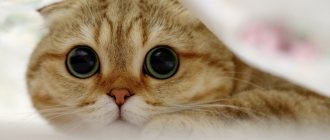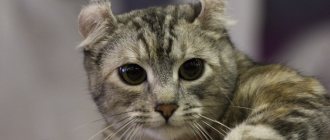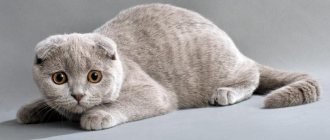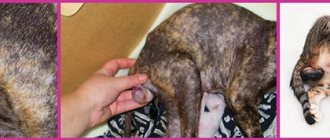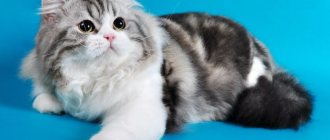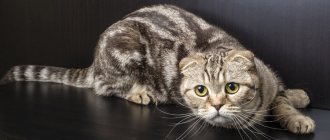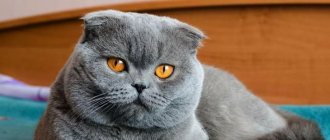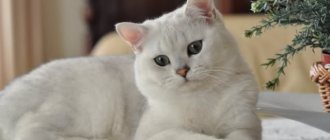Origin and history
The Highland Fold is a Scottish Fold longhair cat that was developed in the 1970s. breeders. This was done on purpose because Scottish folds were popular at that time. In order to develop a new breed, British cats were first crossed with Persians and then with Scottish Folds. Thanks to this, beautiful fluffy fold-eared kittens were born. The colors of these cuties are varied, their shape is round, and their ears are tightly folded and pressed to the head.
Highland fold
History of the origin of the breed
Their origin story has many similarities with the history of the Scotty Fold breed. An interesting and beautiful cat with small and curved ears appeared on one of the Swiss farms, which greatly interested the local workers. When a little heir appeared from her, they decided to breed such an unusual breed, and regularly consulted with local geneticists and cat show judges.
The program for breeding lop-eared rabbits was taken as a basis. Geneticists were interested in the cat's litter, among which there were clearly cats with both long and short hair, which indicated the presence of a gene for the appearance of long hair.
And although cat breeders tried to cross them with short-haired American and British cats, long-haired kittens were born hour by hour. Then the decision was made to sterilize all long-haired Folds. In the early 80s, cats began to participate in shows and at various exhibitions, and already in 1986 they were allowed to take part in championships.
Interesting Facts
British Fold is a Scottish breed of cat.
Interestingly, the first fold-eared cats appeared several centuries ago in the East. However, then they failed to become an independent breed.
Modern fold-eared fluffy kittens appeared in Scotland in 1961 on the farm of William Russo. At first they were rejected and considered a defect in the breed. But these ears gave the kittens an unusually cute facial expression, so the farmer decided to try to breed them as an independent breed. So experienced breeders paid attention to them.
Highland fold kitten
Important! Highland Fold and Highland Straight are different breeds. The second ones have erect ears.
Another fact is the attachment of these cats to family members. As a rule, they consider one person to be their best friend, so they are often bought for children. This is true friendship for life. In European countries, children are taught with the help of these cats. They are present in some school subjects and sometimes even visit students at home. In the USA, children read lop-eared folds aloud, thanks to which the children develop reading skills faster and better.
Highland straight kitten
It is worth remembering that Scottish Fold cats are afraid of heights due to poor development of the vestibular system. They even feel uncomfortable when their owner lifts them off the floor. This has a big advantage - they will not climb on high furniture or climb curtains and curtain rods.
Diseases of longhaired Scottish cats
All folds are susceptible to genetic diseases - osteochondrodysplasia and polyarthritis. Currently, having carried out many years of selection work, breeders have achieved healthy offspring from the correct matings of genetically healthy representatives of the breed (the condition must be met: one parent must be straight-eared, the second parent can be fold-eared or straight-eared). However, if a cat has the fold gene, this means that it is at risk for these diseases. Signs of illness may or may not appear. But the owner must be prepared for such a turn of events.
It is also possible to minimize the risk of choosing a sick animal by not supporting unscrupulous “breeders”, but by choosing nurseries and breeders with a good reputation and positive reviews, purchasing a kitten with documents of origin, where the kitten’s parents are registered, and the mating of the parents is registered in the club (this means that it was carried out in compliance with all rules). Yes, such kittens will cost a little more, but the new family member will delight you with health and well-being for many years.
This aspect when choosing a kitten is very important, because... when buying a known sick animal from improper mating, there is a high probability of losing a baby under the age of 1.5-2 years: the most severe cases of the disease end in death due to the ascending ossification of cartilage, the proliferation of cartilaginous tissue and the fusion of vertebrae from the tail to the head.
If you are still too worried and are not sure that you will be able to choose a healthy pet, and also that you will have to care for a sick cat, pay attention to Scottish Straights and Highland Straights, which do not have the gene for folding ears, and therefore are not susceptible to musculoskeletal diseases apparatus.
Description of the Highland Fold breed
The description of Highland Folds is close to the standards of long-haired Scottish Folds, the only difference being the length of the coat and the fold of the ears.
British longhair cat, fluffy British cat
Breed standard:
- Flexible, round body with well-developed muscles. Females are slightly smaller than males in size.
- The coat is semi-long and fluffy, with a thick undercoat, soft, and has a “collar” and “pants.”
- The coat color is different. The most popular are tortoiseshell and silver, spotted tabby or harlequin, but sometimes solid pussycats are also found.
- The eyes are large, round, most often golden, located on a round head proportional to the body.
- Ears are a distinctive feature of the breed. They are rounded at the ends, pressed tightly to the head, folded 2 times - back and forth towards the middle of the muzzle.
- The legs are muscular and short. The front ones have 5 toes, the back ones have 4. The tail is flexible, thick, at least 2/3 of the body long.
Attention! A short tail is a sign of a defective breed.
Long-tailed fluffy beauty Highlander
Breed standard
The Highland Fold is a semi-longhaired breed and belongs to the Scottish group of cats. Its main feature is its hanging ears. Breed standard:
- Head: Round, with full, prominent cheeks.
- Should be round from any angle.
- The cat should have full, clearly visible whiskers.
- Should be bent forward and down.
- Wide open, round, with an open, curious expression.
- Moderately wide, short.
- It should be medium in size (length excluding tail 55 cm), round, with soft contours.
- Semi-long.
- Seasonal changes in coat length and texture (molting).
- Heavy eyebrows hanging over the eyes.
- Visible signs of illness.
- Curled tail.
Folds have three degrees of lop ears:
- the smallest, when only one fold forms on the ear (folding of the ears depends on the “folding”);
- when there are two folds on the ear, depending on their depth, the ear can fold in half or more;
- third degree, with three folds, is the closest fit of the ear to the head, sometimes with the third degree the ears are almost invisible, such cats are considered the best.
Photo gallery: Highland Fold colors
Two-tone colors look impressive
Tabby colors have a pattern in the form of spots, stripes or marbled stains
As a rule, only females can be tortoiseshells
White color refers to solid (one-color)
Point, acromelanistic, or Siamese colors are also common in Highland Folds.
Smoky and chinchilla colors were inherited by Haland Folds from the British.
Calico color is especially beautiful in combination with white
Ginger cats are always striped
Chocolate color is considered solid
Video: about the breed
Character of the Highland Fold
Golden chinchilla - a cat with a special character
The character of the Highland Fold, like other Scottish cats, is soft and calm. Representatives of the breed quickly find a common language with people, love and appreciate all family members. They are especially close to children. Cute folds will become real friends for kids. They don't scratch or bite, of course, unless you provoke them.
These cats are very tame, so you should only get them if you have time to show care, love and affection towards your furry pet. Despite their jealous nature, Highlands get along easily with other pets.
When guests come, cats do not hide, are not afraid or shy; on the contrary, they love to show off and perform in public. So we can highlight the main character traits of the breed representatives:
- kindness;
- calm disposition;
- sociability;
- attachment to the owner;
- high intelligence;
- curiosity;
- amenability to training.
Highland Folds with their owners
CHARACTER
The long-haired Scottish Fold cat has a character that is considered one of the advantages of the breed. It is no different from other types of Scottish cats. So, the pets of this breed are very friendly, accommodating, they are real companions, somewhat reminiscent of dogs, because... They are very attached to their owners. Unlike British cats, which previously actively participated in the breeding of Scots, the latter are not aloof and proud, but, on the contrary, really need communication, but at the same time they do not impose themselves, but patiently wait for attention to be paid to them. At the same time, this breed, like the British one, is very aristocratic and is well accustomed to the rules of living with people.
Also, well-mannered and socialized Scots, who have a healthy set of genes, for which breeders have been selectively selecting for years, leaving only the best traits and qualities of the breed, are devoid of aggression, rancor and mischief. A Scottish cat is unlikely to do anything out of revenge. And in general, the Scots are great optimists and very easy-going cats. They are also quite calm. Although there are exceptions to any rule.
Highland Fold Darcy - calm, flexible and gentle
A negative feature of the Scots is that many of them do not like to sit on their hands. But this does not stop the Scots from lying in their arms next to their owner, giving him another dose of affection. Owners of cats who are good at sitting in their arms will be very lucky: to all the advantages of the Scottish cat’s character, their pets also have the fact that they are tame “buns.”
Of course, kittens under one year old do not quite correspond to this description, because... They are, as a rule, hyperactive, obsessive, often talkative and not yet fully educated. This is normal behavior for a healthy, growing, developing animal. And the little ones need their mother, so they can lie in their owner’s arms for a long time, which often goes away when they reach adolescence.
But you also need to understand that each cat is an individual, which is formed not only by genes (and they can also fail), but also by upbringing. It will depend on the breeder and directly on the owner. From the first days, the kitten must be taught the rules of behavior in your family and not allowed to do anything that you would not want an adult cat to do. After all, this little lump will grow up sooner or later, and his childhood habits will remain with him.
In a sexual sense, the Scottish breed is considered moderately active. That is, cats organize concerts, but still their behavior is not as bright as, for example, that of animals of the eastern flood. However, in order to avoid behavioral problems with the onset of puberty (marking, screaming, aggression), pets that are not subject to breeding must be neutered.
Caring for eyes, ears, teeth and claws
The main problem of Highland Folds is ear care. Since they are wrapped and pressed tightly to the head, cats cannot do it on their own. They definitely need help with this. They should be cleaned once a week using a cotton swab or rolled-up cotton pad. To make it easier, you can purchase ear drops at a specialized store. They will soften accumulated plaque and dirt.
Important! You can’t insert the stick too deeply; just gently move it along the edge of the ear.
Representatives of the Highland Fold breed have a tendency to cry frequently. You need to keep an eye on this and regularly wipe their eyes with a soft cloth. The main thing is that there are no lint or other small components on it that can enhance the effect.
In order to eliminate plaque on the teeth, it is necessary to introduce dry food into the animal’s diet. If the owners have relied on natural nutrition, then chewing large pieces of meat will help cope with this problem.
Pet stores offer a wide variety of special sticks, toys, and you can also buy toothpaste for cats, which you should use to brush your cat’s teeth once a week.
Like all cats, Highland Folds love to sharpen their claws. To avoid damaged furniture, clothes and carpets, you need to purchase special scratching posts. But it happens that even after its appearance in the house, the claws remain long and sharp. This can have a negative impact on the animal itself and those around it. There is a nail clipper especially for such cases. It is useful for every cat breeder to have.
Advice! If an owner is wary of trimming a cat's nails themselves, this service is available at most veterinary clinics.
Highland fold kitten with scratching post
Appearance
Beautiful and sophisticated, Highland Folds have several distinctive features that make this breed absolutely unique and inimitable. What is noteworthy is that in this breed, males and females have slightly different features in appearance, which also characterizes them as unique representatives of the cat family.
- Highland Folds are small cats with a medium-sized body. The body of cats is squat and muscular. The weight of cats varies from four to eight kilograms. Females differ from males in having a more graceful and slender physique.
- These cats have short but powerful legs. There are tufts of hair between the toe pads, which makes the cat's tread soft and inaudible.
- The tail of cats is relatively long, tapering at the end. The entire length of the tail is covered with luxurious and long hair, which makes it look like a fan.
- The Highland Fold has a large, round head with a well-developed jaw and strong chin. The animals' muzzles are short, with a small graceful nose and a wide forehead.
- Eyes are another distinctive feature of the Scottish Longhair cat. They are large, expressive, and their color matches the color of the cat's fur.
- Representatives of this breed have small ears, the tips of which are curved and directed downward, perpendicular to the skull. Since cats are very fluffy, due to their long hair, their ears are almost invisible, and it seems that they are not there at all.
- Highland Folds have long and luxurious fur, their coat is soft and pleasant to the touch. On the chest of cats, a long pile forms a luxurious collar, and the hind legs are crowned with peculiar woolen panties, but this feature is most pronounced in males.
- The colors of these cats are varied. There are individuals with a completely uniform color and with colored spots scattered throughout the body. But most of all, lovers of this breed value representatives with silver-blue, iridescent fur.
Optimal nutrition
The maximum amount of food that is recommended to be given to cats of this breed is 250 g per day. When creating your own diet, you should focus on 80% lean meat (beef, rabbit or turkey are best). It is useful to give your cat boiled offal 1-2 times a week.
Fermented milk products and boiled egg yolk are given periodically. Porridge - rice, buckwheat, oatmeal - must be included in the daily diet.
It is worth adding plant products in raw or boiled form. To make it tastier for your cat to eat, it is better to add plant components to meat products.
Additional vitamins and minerals are purchased at a pet store after consultation with a veterinarian and are constantly added to the food.
Highland Folds are very fond of grass, which you can grow yourself from seeds sold in specialized stores. In summer you can give some varieties of ordinary sedge growing outside.
Important! Thanks to the use of grass, cats will be able to get rid of hairballs that accumulate after constantly licking their fur coat.
Products that are strictly prohibited from being included in the Highland Fold diet:
- cow's milk;
- potatoes in any form;
- legumes;
- mushrooms;
- sweets and bakery products;
- canned foods;
- fried foods, smoked meats and marinades.
If the owner decides to feed the pet with ready-made food, then you should choose premium products; you should not give the fluffy beauties mixtures sold in mass markets.
Important! Food from the master's table should also not end up in the Highland Fold's bowl. It contains salt, sugar and spices that are unacceptable for the sensitive digestive system of the animal.
Kittens under 6 months of age are fed 4-5 times a day, adolescents - 3 times a day, for adult cats, feeding should be reduced to 2 times a day, in the morning and evening hours. The water bowl should always be filled and changed twice a day.
Care
Caring for Highlands does not require any specific skills. Even if this is your first pet, you should know that caring for it will be very easy.
Wool
Highland Fold cats have very pliable and soft fur that does not mat or mat, although it is considered long.
To prevent pieces of fur from accumulating in the stomach, it is necessary to comb your pet at least twice every seven days. When shedding occurs, this process should be done more often.
To keep the fur clean, these cats need to be bathed periodically. But remember, they do not tolerate water, so there is no need to do this too often. A sufficient frequency in this case is once every 6 months using cat shampoo. The water should not exceed a temperature of 40–44 degrees.
Nutrition
There is no need to follow any diets for this breed, but there is a need to pay attention to the frequency of feeding, as overeating can have a detrimental effect on your pet’s health.
- The volume of daily feed should not exceed 250 g. 80% of the diet should be meat such as poultry, rabbit or beef.
- You can also boil Highland offal, but not more than 2 times every 7 days.
- Sometimes you can feed your pet boiled yolk and fermented milk products.
- These cats love well-boiled porridge, so don’t deny them this pleasure.
- You can also boil the plants and, to ensure that the cat does not refuse this food, mix it with pieces of meat.
- Plant special grass from the pet store on the windowsill. It will help your cat get rid of hairballs in her stomach.
Never buy or feed your Highlands the following foods:
- potatoes;
- milk from the cow;
- bread;
- sweets;
- mushrooms;
- legumes;
- seasoned and canned foods;
- fried foods.
When choosing ready-made food, you should give preference to premium products. Giving food from the table is strictly prohibited.
Up to six months, feeding is carried out 5 times a day, before a year it is reduced to three times, after a year - to two. Also, the cat should always have fresh water in its bowl.
Walk
This domestic breed does not need to be walked. She feels great at home. A city apartment is the perfect place for a Highlander. If you live in a private house, then you shouldn’t worry either. Curious pets will have no problem walking in the yard or sleeping on the windowsill with the window open.
Scottish Fold cat health
Highland Folds have a fairly high immunity to most diseases. But there are a number of problems that these kittens can face.
Osteochondrodysplasia
This is a serious, incurable pathology. Most often this problem occurs due to incorrect knitting. This disease provokes lameness, disorientation in space, deformation of the limbs, and delayed development.
In order to alleviate the course of the disease, veterinarians prescribe special medications. They stabilize the general condition of the cat and prevent further progression of the disease.
Urolithiasis disease
This is another problem that often occurs in Scottish Fold longhair cats. Males, especially neutered ones, suffer from it more often than male cats.
If an animal has difficulty going to the toilet, or there are particles of blood in its urine, immediate intervention by a specialist is necessary. If this is discovered late in the evening, when the doctor is no longer attending, the owner can put a warm heating pad on it to relieve the spasm and ease the animal's suffering.
Heart diseases
This problem is less common in the Scottish Highlands. Its main manifestations are shortness of breath and irregular heartbeat. The doctor will prescribe recommendations on the pet’s diet and lifestyle.
Obesity
It's a problem for all Scots. This can only be prevented by proper nutrition, the principles of which cannot be deviated under any circumstances.
Important! You also need to monitor the condition of the eyes, wipe them and care for them. But various drops, the choice of which is very large today, will help cope with eye diseases.
Health
In the past, Scottish Longhair cats were free-ranging, meaning they hunted and roamed the snowy slopes. Such a past has rewarded them with good health and endurance. This is why Highlands are strong and rarely get sick.
The lifespan of the breed is 15-20 years. So that the life of the cat and the owner is not overshadowed by health troubles, it is necessary to regularly carry out deworming and prevention against parasites. An annual visit to the veterinarian, who will examine the animal and advise the owners on food and nuances of caring for the pet, will not be superfluous (and even mandatory).
The Scottish Longhair cat is a very rare breed. However, those who managed to get acquainted with the fluffy beauty will never stop loving this cat again, because her appearance is ideal, and her character is truly cat-like.
If you have questions on the topic, ask us.
Breeding
If Highland Fold breeders are thinking about breeding the breed, this can only be done by adhering to a number of rules:
- Under no circumstances should two lop-eared individuals be crossed. With such inbreeding, kittens with various kinds of genetic pathologies will be born. You can consider Highland Straight as partners. This option will be ideal.
- The female becomes ready for mating and childbirth only after reaching 1.5 years of age. It is best if the first mating process occurs during the cat’s 3rd heat.
- The cat-male meeting should happen on the second day of estrus.
- The female and male must be vaccinated and treated against parasites.
- It is better if the color of the partners is approximately the same, and the size of the cat exceeds the size of the female.
Name
The Scottish longhaired cat breed - Highland Straight and Highland Fold - got its name in honor of the highland regions of Scotland, where the wild ancestors of modern longhaired Scottish cats used to live.
Modern fashion for cats has slightly pushed the long-haired breed into the shadow of its older brother, the Scots Shorthair. However, considering the appearance and temperament of these wonderful fluffies, we can say with confidence that this did not happen deservedly.
Purchasing a Highland Fold kitten
Highland Fold cats are quite rare, but nevertheless many breeders love them, and children simply dream of owning such a cute, unusual cat. Kittens' ears are initially erect; they bend 3 weeks after birth. And at 3 months, babies can already be put up for sale, since it is at this time that folds can be distinguished from straights, the difference between them becomes obvious.
How to choose a kitten
Before purchasing a kitten, it is worth visiting a nursery and observing it in its natural environment. This will help you choose a pet with the desired character, as well as monitor the animal’s physical condition and health.
Offspring of Highland Folds
A healthy kitten has fluffy, soft fur, no bald spots, and clean eyes. The cat himself is sociable, active, playful, and friendly. If all these signs are present, then the little Highland Fold is healthy and without congenital pathologies.
Important! Particular attention should be paid to the tail of the animal. It should not be short, and should be actively moving and flexible. Such a check must be carried out, since congenital joint disease is often transmitted along with the lop ear gene.
How much does it cost and where to buy
The cost of the baby depends on the place where it is purchased. A purebred kitten, purchased from a trusted cattery, with a good pedigree and a complete package of documents, can cost up to $1000. However, if there is no pedigree, a cat can be purchased for less than $100.
Highland Folds are sold in nurseries. There are enough of them in Russia, among them you can choose the one closest to your home and with the best reputation. Kittens without a pedigree are also sold on well-known websites specializing in the sale of various products.
Important! When purchasing a pet without a pedigree, you should be careful, since it is possible to purchase a representative of a completely different breed, with different characteristics.
Story
The Highland Straight is a relatively young cat breed that appeared as a result of crossing two popular species. It was from the meeting of the Scottish Shorthair cat and the Persian cat that exquisite fur kittens were born.
Scots kitten
But the history of the emergence of wild relatives begins much earlier. Back in the 18th century, freedom-loving furry murkas lived in the mountains, hunted and lived for their own pleasure. This continued exactly until the moment when inquisitive cat lovers discovered this beauty.
Felinologists set out to obtain a gene from mountain cats that would give domestic cats such a spectacular fur coat. It was possible to achieve a lasting result of crossing only in the middle of the last century. An elegant long-haired cat appeared before the world, inheriting from its ancestors not only a luxurious fur coat, but also a wonderful disposition.
Subsequent crossing and improvement of the breed allowed the Scots to acquire a wide variety of colors.
However, the furry beauties have not yet managed to overtake the “elder” short-haired brother in popularity.
The species received official confirmation for the first time only in 1970. Many years passed before other organizations, including TICA and WCF, recognized the existence of the breed.
Adaptation of a kitten in a new home
For a small 3-month-old kitten, a new home is someone else's home. Therefore, when purchasing, be sure to consult with the breeder about the baby’s preferences. In the apartment where he will live, you need to have a minimum set of necessary items.
First, you should show him the kitchen, the toilet, the corridor, and only then let him into the rest of the rooms. This can be done only after the baby understands where the toilet is. Otherwise, problems may arise with this.
A handsome fluffy dog with folded ears and fur that is smooth and thick, like a chinchilla’s, this is a Highland Fold. His cuteness makes you fall in love at first sight. An easy-going character, friendliness and affection are what families with children need. Animals of this breed will delight their owner from the very first day for many years.
Mr. Cat recommends: character traits
Cats of this breed have an amazing, gentle and peaceful character in the cat family, even among domestic cats. They become very attached to a person, while most of their brothers still rather experience tender feelings for a specific place. They need manifestations of love and care, love affection and sitting on laps.
Many Highland Folds have one peculiarity: when they are interested or surprised by something, they sit down on their hind legs, reminiscent of a meerkat.
If there are children or other animals in the house, even those that naturally cause a hunting stance in the cat, you don’t have to worry: Highland Folds get along well with all representatives of the fauna, including dogs, rodents and birds. As a rule, they treat strangers without fear and wariness, they willingly go into their arms and allow themselves to be stroked. They generally like people's attention.
If people are busy, then the Highland Fold will not persistently pester, demand games or other forms of attention. They will perfectly find something to do on their own. At the same time, cats of this breed are very careful; as a rule, they do not pay attention to furniture, curtains and other interior items in order to sharpen their claws or otherwise damage them.
Kittens of this breed, like other kids, love to play and run, so the pet needs to prepare cat entertainment and toys in advance. They love to play with people, but you can safely leave them with children: they are absolutely not aggressive, they will not scratch or bite.
As cats mature, they become calmer, even sedate. If the owners are constantly at work, this does not cause any discomfort to the Highland Fold; he easily remains alone, but is very happy when people come. However, for this cat, schedule, order, and feeding at certain times are extremely important. She really doesn’t like the lack of orderliness, especially if there are interruptions in meals.



